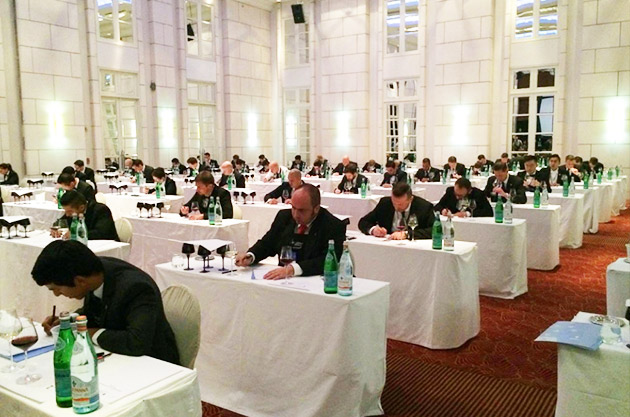Read on to see who has won the Best Sommelier in the World competition in Mendoza - the Olympics for sommeliers...
- Sweden’s Arvid Rosengren named Best Sommelier in the World in Mendoza final
- New York-based Rosengren says it is a victory for ‘hip hop and wine’
- Most competitors spend six years preparing for the event
Arvid Rosengren emerged from a field of 15 semi-finalists to claim the top prize at the best sommelier in the world competition in Mendoza, Argentina, at 1am local time on Wednesday 20 April.
‘It’s a dream’
‘I’m in a dream state,’ the 31-year-old sommelier said after being announced the winner in the black tie event.
Sommelier at a trendy New York restaurant for the last two years, Rosengren breaks the mould of the previous winning sommeliers. ‘At work I wear a buttoned-down shirt and sneakers, we play loud hip hop and drink old wine.’
Six years of preparation
Most competitors have been preparing for at least six years for the tournament, which takes place every three years.
Sleepless nights, thousands of pounds invested in rare bottles, and zero social life are common elements of preparation. Japanese candidate Hiroshi Ishida spent last month living away from his wife and three children, for his final purgatory of preparation.
This year’s competition saw a record 61 candidates enter, and it cost the Argentine Sommelier Association £0.5m to host.

Quarter-Finals: Can you list Germany’s wine regions in reverse size order?
The quarter-finals kicked off with a blind tasting of two wines and four spirits, a theory exam and a service test.
A planned pitfall in the practical exam was failing to notice a dirty speck on one Champagne glass, and candidates reported theory questions asking for all the AOCs in Belgium and to list Germany’s wine regions by reverse size order.
The eventual semi-finalists were:
- Christian Jacobson from Denmark
- Heidi Makinen from Finland
- Henrik Dalh Johansen from Norway
- Raimonds Tomsons from Latvia
- Robert Andersson from Sweden
- Arvid Rosengren from Sweden
- Hiroshi Hishida from Japan
- David Biraud from France
- Paz Levinson from Argentina
- Satoru Mori from Japan
- Elyse Lambert from Canada
- Piotr Pietras from Poland
- Alexander Rassadkin from Russia
- Gareth Ferreira from South Africa
- Julie Dupouy from Ireland

The 15 semi-finalists rose early the next day for 10 tests, including another written theory, blind beverage and wine tasting, a restaurant wine menu proposal, food and wine pairing and dealing with tricky clientele.
‘The semi-final is always really hard – you are tired and you have to keep focused,’ explained Argentina’s Paz Levinson, already Best Sommelier of the Americas, who was papped by national press throughout.

Monday was a day off, before Tuesday afternoon’s final in front of 500 people and tv cameras at the Teatro Independencia in Mendoza city centre.
‘We have 15 incredibly talented semi-finalists but we will keep only three,’ announced Gerard Basset OBE MS MW, Best Sommelier in the World 2010 and co-chair of the Decanter World Wine Awards. ‘The winning semi-finalists keep 50% of their points from the quarter-final.’
The finalists announced were the two favourites from the outset, David Biraud from France and Arvid Rosengren from Sweden, and a dark horse, Julie Dupouy, representing Ireland. Rosengren was first on stage as the curtain lifted to reveal a mock restaurant with 23 judges eyeballing the competitors.

First up was a service task to make a dry martini and serve three glasses of a Champagne that was not in the ice bucket. Each candidate correctly offered an alternative.
A whirlwind of tests over the different judging tables tested their ability to serve, blind taste, pair a wine list with a menu, spot mistakes in a wine list, and convince some clients to buy a few cases of an expensive wine.
‘This was not my first time in the finals, but there were lots of new tasks this year,’ Biraud said. ‘The most difficult part is to not feel the pressure.’
Candidates then had to recognise images shown on screen for 15 seconds, including of DecanterChina columnist Li Demei, Almaviva winery, and a Daktulosphaira Vitifoliae.
Finally, each candidate had to pour a magnum of Champagne equally into 15 glasses without any re-pours and empty the bottle. Tension was palpable, and it took seven minutes to do.
A short tango interlude eased the tension as the judges totted up the final scores.

An engraved Champagne bottle trophy was duly wheeled on stage before the finalists’ sweating brows and Shinya Tasaki announced Rosengren as the winner.
Biraud came second, Dupouy third, Paz Levinson fourth and Elyse Lambert fifth – making it three women in the top five of what has often been known as an all-gents club.
Updated 22/04/2016







